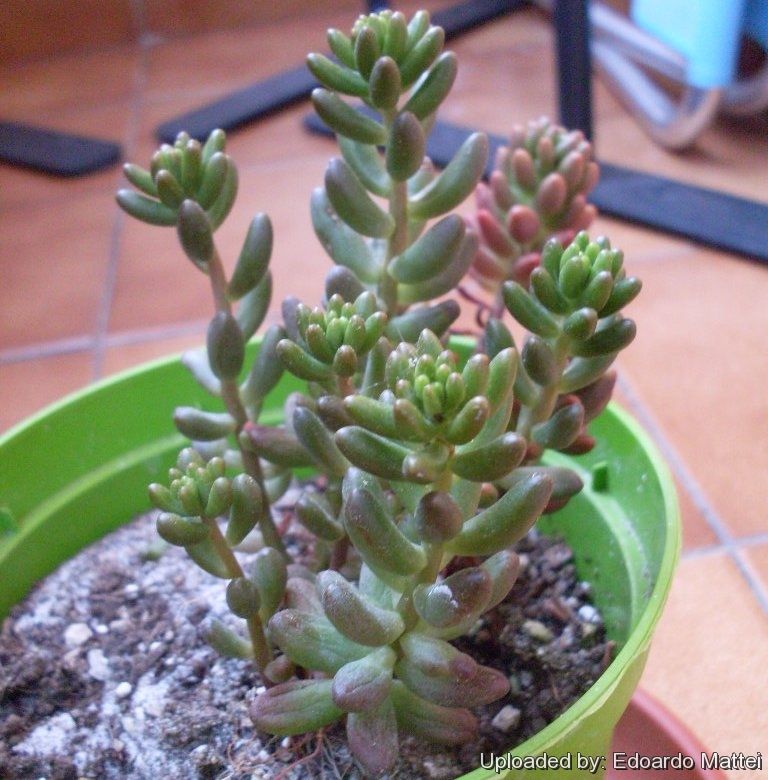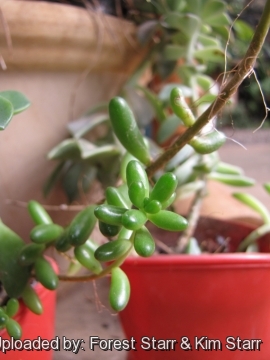




Your support is critical to our success.

Origin and Habitat: Mexico.
Synonyms:
- Sedum х rubrotinctum R.T.Clausen
ENGLISH: Jelly bean plant, Brownbean Sedum, Baby's-toes, Jelly Beans, Pork-n-beans, Porks and Beans
CHINESE (中文): 耳墜草
JAPANESE (日本語): ニジノタマ
MALAY (بهاس ملاي /Bahasa Melayu ): Pokok Kacang Jeli
RUSSIAN (Русский): Очиток красноокрашенный
Description: Sedum rubrotinctum is a miniature hybrid of two choice Mexican species Sedum pachyphyllumSN|19403]]SN|19403]] and Sedum stahlii and commonly known as the jelly bean plant, or pork and beans. Its easily broken leaves, that look like jelly beans, are arranged in a unique spiral around the slender stems and on plants grown in the sun, they're often entirely bronze red.
Habit: It is a low-growing bushy or ground-hugging succulent up to 10 cm tall, with leaves mass along short stems. It spreads over time by rooting stems and fallen leaves that easily take root to form a dense ground cover. It may become very straggly with age. Young plants may be quite compact and will flower, when they are quite small.
Stems: Sprawling, leaning, somewhat woody at base, much branched, upright at first, but later curved and trailing. Up to 20 cm long, but usually less and bare in the lower half. In time of drought the stems carry only a small terminal cluster of leaves.
Leaves: Short (up to 2 cm long), thick, ovate to cylindrical looking like green jelly beans with a glaucous-bluish bloom. Leaf tips usually turn red in winter when kept dry or in full sun as a protective adaptation.
Flowers: Bright yellow with a reddish tinge.
Blooming season: Mid-spring.
Bibliography: Major references and further lectures
1) A. Cort Sinnes “Sunset house plants” Lane Pub. Co., 01/Sep/1983
2) Yvonne Cave “Succulents for the contemporary garden” Timber Press, 01/Jan/2003
3) Desert-tropicals.com.. "Pork and Beans (Sedum rubrotinctum)" [.http://www.desert-tropicals.com/Plants/Crassulaceae/Sedum_rubrotinctum.html] Accessed on 2014/06/08
4) Wikipedia The Free Encyclopaedia “Sedum rubrotinctum” [http://en.wikipedia.org/wiki/Sedum_rubrotinctum] Accessed on 2014/06/08

Sedum х rubrotinctum Photo by: Edoardo Mattei

Leaves at Sacred Garden of Maliko, Maui, Hawaii (USA). January 24, 2011. Photo by: Forest Starr & Kim Starr
Cultivation and Propagation: Sedums rubrotinctum is an easily grown succulent that can tolerate sun, shade, moist soils, dry soils, but looks its best only when given adequate light levels and water, and ideally should be grown outdoors in full sun. S. rubrotinctum is cultivated as an ornamental plant, it makes a superb container plant in frost-prone areas and can be an attractive part of rock gardens between stepping stones or in wall niches in frost-free localities. With its extreme drought resistance, S. rubrotinctum needs only minimal care to reward you with its attractive jelly bean texture, bright red summer leaves and spiky yellow flowers, although attractive, it can become a nuisance as the leaves fall off and produce new plants wherever hit the ground.
Exposure: Generally speaking, the more light a plant gets the better it will display its colours and shape. Bright light is required to prevent "stretching" of Sedums ("stretching" occurs when a moderately fast growing plant such as an Sedum, is grown in dim light or over-fertilized, which causes overly lush growth that contributes to weak, pallid plants). However, when moving plants from lower light conditions into full sun, be wary of sun scorch resulting from too rapid a transition into intense summer sunlight, most easily avoided by ensuring plants are well-watered before moving them on a cloudy day.
Waterings: Sedums are able to tolerate extended dry periods and survive drought without the need for watering, but they will grow stronger if they receive adequate moisture during their growing season, but never allowing the plant to remain waterlogged (root rot sensitive). Avoid overhead watering under humid conditions, especially during winter.
Soil: It is essential in cultivation to use a very porous soil, which will allow quick drainage. Sedums are shallow rooted plants, and therefore benefit from good levels of organic matter in the soil. Give it enough root space for optimum growth.
Fertilization: Slow release fertilisers with a low to moderate nitrogen content incorporated into the potting mix are usually adequate for the spring and summer growing seasons of Sedums, and additional fertiliser applications would not normally be required until spring.
Ventilation: Good air movement is important for minimising pest and disease risks, and avoiding excessive humidity in cool winter conditions is important to successfully growing Sedums in the nursery environment.
Hardiness: Can tolerate light frosts however, the ideal temperature range during the summer growing season is 5-25°C, with the cooler autumn temperatures tending to make their foliage colours become more intense than those of the active summer growing season.
Pests and diseases: Aphids like this plant (and all flowering sedums).
Warning: Causes stomach irritation if ingested; skin irritation from sap contact.
Propagation: It is easily propagated by cuttings in the spring. When the stem becomes too tall, just cut the top rosette with a piece of stem and plant it. It will soon take root, while the plant left with just the stem will soon grow new buds that can be in turn used for propagation. Time to take cuttings: April to July. New plants may be grown from leaves (or beans) that drop off or are separated from the stem and laid on the soil. If the plant is repotted some of the bottom leaves can be removed, in order to attempt propagation. However some of the cuttings will dry out without producing a plantlet.
| Your Actions | |
|---|---|
| Back to Sedum index | |
| Back to Crassulaceae index | |
 |
Back to Succulents Encyclopedia index |
Privacy stantement - Terms and conditions - How to cite - About us - Feedback - Donate



